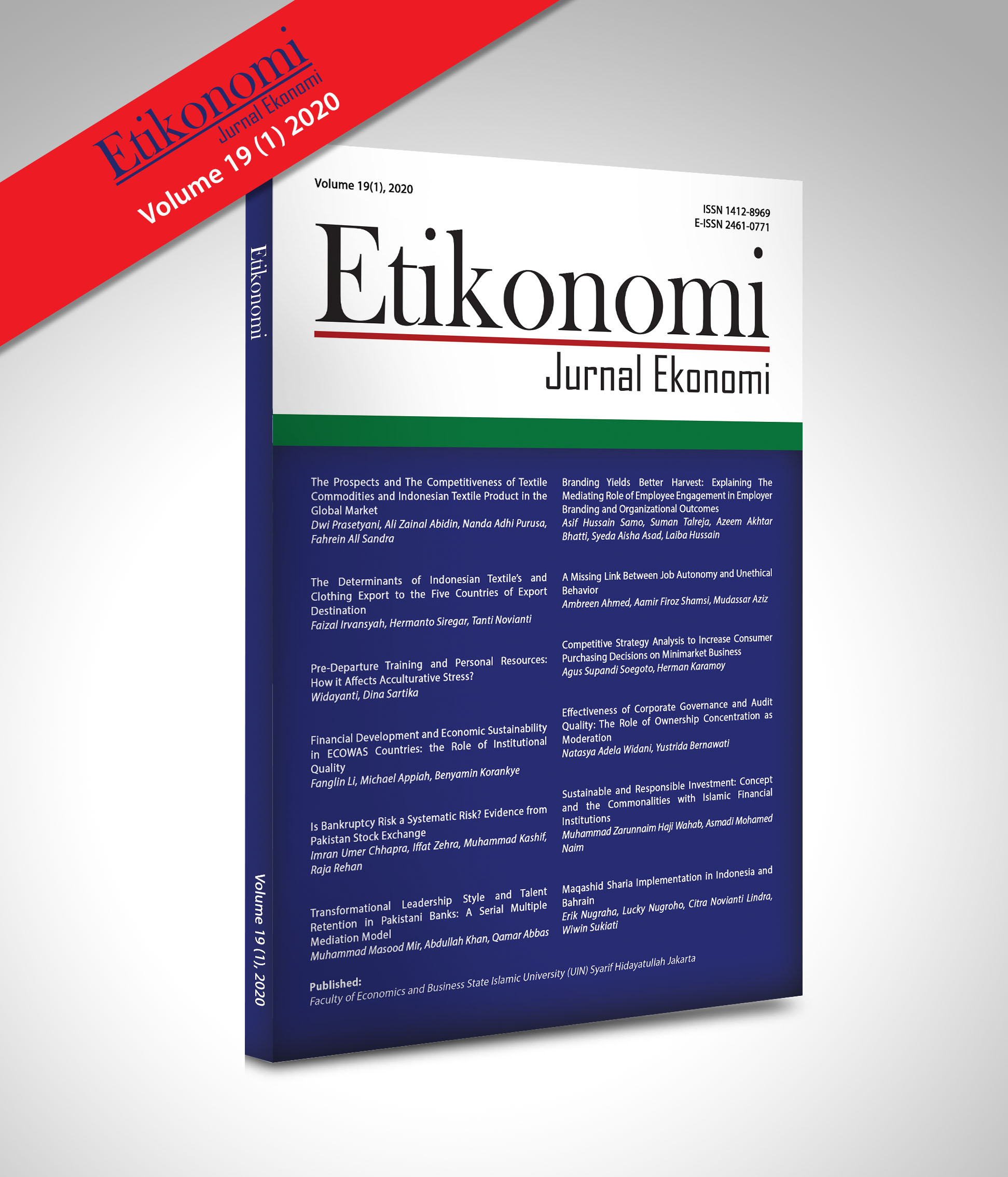The Determinants of Indonesian Textile’s and Clothing Export to the Five Countries of Export Destination
DOI:
https://doi.org/10.15408/etk.v19i1.14845Keywords:
textile and clothing product, the competitiveness of textile and clothing, exportAbstract
Indonesian textile and clothing products (TPT) is the second-largest export product after oil palm product. There are five biggest export destination countries, that is the United States, Japan, South Korea, and Turkey. This study aims to analyze the factors that affect TPT exports to the five biggest export destination countries. The factors that affect TPT exports examined by using time series and panel data analysis. Using panel data analysis finds that GDP per capita of the destination country, the exchange rate of the Rupiah, the price of textiles in the destination country, and import tariffs stipulate in the destination country affect TPT exports. Then, using time series analysis finds that GDP per capita and import tariffs affected TPT export to the United States, China, and Turkey. Meanwhile, the factors influencing Indonesian textile exports to Japan and South Korea are textile prices, rupiah exchange rates, and import tariffs.
JEL Classification: F14, F43
How to Cite:
Irvansyah, F., Siregar, H., & Novianti, T. (2020). The Determinants of Indonesian Textile’s and Clothing Export to the Five Countries of Export Destination. Etikonomi: Jurnal Ekonomi, 19(1), 19 – 30. https://doi.org/10.15408/etk.v19i1.14845.
Downloads
References
Ahmad, K., Qasim, M., & Chani, M. I. (2017). Impact of Exchange rate on Exports in Case of Pakistan. Bulletin of Business and Economics, 6(2), 98-102.
Asmara, A., Yeti L. P., Sri M., & Tanti N. (2016). The Alternative Strategy For Strengthening Indonesian Textile and Clothing Industry Structure. Jurnal Bisnis & Manajemen, 17(1), 33-47.
Balassa, B. (1965). Trade Liberalisation and “Revealed” Comparative Advantage. Manchaster School. 33(2), 327-344. https://doi.org/10.1111/j.14679-957.1965.tb00050.x
Baskol, A. O. (2018). International Competitiveness in Turkish Textile and Clothing Sector. Journal of Management Economics and Business, 14(3), 643-658.
Chamroel, D. (2003). Ideas Regarding TEXTILE’S Industry and Trade Development. Jakarta: API & Cidesindo.
Ekananda, M. (2004). Analisa Pengaruh Volatilitas Nilai Tukar Pada Ekspor Komoditi Manufaktur Di Indonesia (Analysis of the Effect of Exchange Rate Volatility on Exports of Manufacturing Commodities in Indonesia). Buletin Ekonomi Moneter dan Perbankan, 7(2), 197-235
Eve, M. H. C., & Au, K. F. (2006). Determinants of China’s Textile Exports: An Analysis By Gravity Model. Journal of The Textile Institute, 98(5), 463-469
Guisan, M., & Cancelo, M. (2002). Econometric Models of Foreign Trade in OECD Countries. Econometrics and International Development, 2(2), 65-81.
Harjanto, E., & Purwanto, E. H. (2010). Konversi Standar Nasional Indonesia [SNI] ke Harmonized System [HS] (Conversion of Indonesian National Standard [SNI] to Harmonized System [HS]). Jurnal Riset Industri, 4(2), 41-56.
Hatab, A. A. (2017). Made in China: The Displacement Effect of China on Egyptian Textile Export. Journal of Agribusiness in Developing And Emerging Economies, 7(2), 99-114.
Hendria, M. (2017). Strategi Pengembangan dan Peningkatan Daya Saing Industri Pakaian Jadi Indonesia (Strategy for Developing and Increasing the Competitiveness of the Indonesian Apparel Industry). (Unpublished Thesis). Bogor: IPB University.
Hwang, E. J., & Norton, M. J. (2012). United states-korea free trade agreement and effects on the U.S. and korean textile and apparel industries. The Business & Management Review, 3(1), 129-137.
Indonesian Ministry of Trade. (2015). Analysis of Import Policies In Export Destination Countries. Jakarta: Secretariat of the Directorate General of Foreign Trade.
Kathuria, L. M. (2013). Analyzing Competitiveness of Clothing Export Sector of India and Bangladesh. Competitiveness Review, 23(2), 131-157.
Khan, S., ul Haq, I., & Khan, D. (2013). An Empirical Analysis of Pakistan's Bilateral Trade: A Gravity Model Approach. The Romanian Economic Journal, 16(48), 103-120.
Kuncoro, M. (2013). Indonesia's Textile and Its Products Industry: Recent Development and Chalanges. International Journal of Business and Economic Development, 4(2), 60-74.
Kusuma, R. L., & Firdaus, M. (2015). Daya Saing dan Faktor yang Mempengaruhi Volume Ekspor Sayuran Indonesia Terhadap Negara Tujuan Utama (Competitiveness and factors affecting Indonesia’s Vegetable Export Volume Against Major Destination Countries). Jurnal Manajemen dan Agribisnis, 12(3), 226-236.
Latif, R., & Javid, A. Y. (2016). The Determinants of Pakistan Exports of Textile and Integrated Demand and Supply Approach. The Pakistan Development Review, 55(3), 191-210.
Mankiw, N. G. (2007). Principles of Economic (4th Edition). USA: Thompson Higher University.
Mira., & Saptanto, S. (2017). Pengaruh Kebijakan Perubahan Tarif Impor Terhadap Sektor Kelautan dan Perikanan (The Effect of Import Tariff Policy on The Maritime and Fisheries Sector). Jurnal Kebijakan Sosial Ekonomi Kelautan dan Perikanan, 7(1), 13-25
Putra, M. A., Emilia., & Chandra, M. (2018). Pengaruh Kurs dan Harga Ekspor Komoditas Unggulan Provinsi Jambi (The Effect of Exchange Rate and Jambi Province Commodity Export Commodity Prices). e-Journal Perdagangan, Industri, dan Moneter, 6(1), 45-61.
Schwab, K. (2017). The Global Competitiveness Report 2017-2018. Geneva: World Economic Forum.
Stiglitz, J. (1993). Principles of Macroeconomic. New York: W.W. Norton and Company, Inc.
Trevisani, P. (2015). Brazil Studies Cutting Import Tariffs. Wall Street Journal, 1-3. Retrieved from: https://www.wsj.com/articles/SB10001424127887324110404578628490871 293104
Wahyuni, S., & Boeditomo, P. T. (2015). Does Quality of Work Life Influence Competitiveness? A Comparison Between Indonesia and Vietnam. Global Business and Managemenent Research: An International Journal, 7(1), 32-59.
Zainuddin., Sinaga, B. M., Hartoyo, S., & Erwidodo. (2019). Assessing Market Power, Impact of Import Tariff Reductions and Weakening Demand for Rubber Products (HS Code 4011) in the Australian Market. International Journal of Economic and Financial Issues, 9(2), 59-72
Zyl, G. V., & Matswalela, K. (2016). A Comparative Analysis of The Level of Competitiveness of The South African Clothing and Textile Industry. Journal of Economic and Financial Sciences, 9(2), 370-391.










